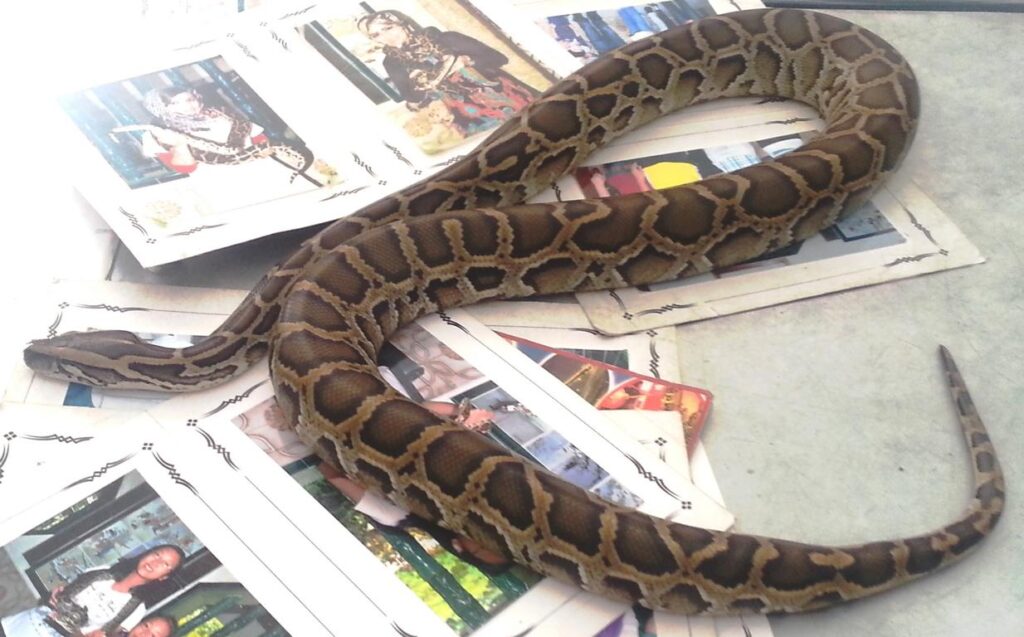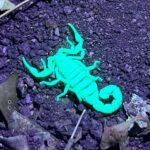Bites from venomous snake species appear to be the highest concern when walking in the Siberut forests. There are anecdotal reports that middle-aged Mentawai men were bitten by pit vipers three or four times in their lives.

Non-Venomous Snakes (Harmless to humans)
On Siberut Island, 40 species of snakes have been documented. Out of this total, 23 species are non-venomous and harmless to humans. These species are:
- Black-headed Snake, Striped (Sibynophis geminatus)
- Bridal Snake, Malayan (Lycodon subannulatus)
- Bronzeback, Elegant (Dendrelaphis formosus)
- Bronzeback, Southern Painted (Dendrelaphis pictus)
- Bronzeback, Stripe-tailed (Dendrelaphis caudolineatus)
- Kukri Snake (Oligodon sp.)
- Malayan Bridal Snake (Lycodon subannulatus)
- Python, Reticulated (Malayopython reticulatus)
- Python, Sumatra Short-tailed (Python curtus)
- Racer, Yellow-striped (Elaphe flavolineata)
- Rat Snake, Red-tailed Green (Gonyosoma oxycephalum)
- Rat Snake, Yellow-striped (Coelognathus flavolineatus)
- Reed Snake, Collared (Calamaria pavimentata)
- Reed Snake, Sumatra Dwarf (Pseudorabdion eiselti)
- Reed Snake, Variable (Calamaria lumbricoidea)
- Slug Eater, Smooth (Asthenodipsas laevis)
- Slug-snake, Blunt-headed (Aplopeltura boa)
- Sunbeam Snake, Common Asian (Xenopeltis unicolor)
- Water Snake, SE Asian Dog-faced (Cerberus schneiderii)
- Whip Snake, Short-nosed (Ahaetulla prasina)
- Whipsnake, Malayan (Ahaetulla mycterizans)
- Whipsnake, Speckle-headed (Ahaetulla fasciolata)
- Wolf Snake, Malayan Banded (Lycodon subcinctus)

Slightly Venomous Snakes (Mildly venomous to humans)
From a total of 40 species, eight species are rear-fanged and only slightly venomous to humans. These snake species are:
- Cat Snake, Black-headed (Boiga nigriceps)
- Cat Snake, Dog-toothed (Boiga cynodon)
- Cat Snake, Jasper (Boiga jaspidea)
- Cat Snake, Pale-spotted (Boiga drapiezii)
- Flying Snake, Twin-barred (Chrysopelea pelias)
- Keelback, Triangled (Xenochrophis trianguligerus)
- Keelback, Speckled-bellied (Rhabdophis chrysargos)
- Mock Viper, Common (Psammodynastes pulverulentus)
Some Rhabdophis species can be dangerously toxic, but the Speckled-bellied Keelback snake (R. chrysargos) within this genus is considered only mildly venomous.
Venomous Snakes (Medically Significant)
The remaining snakes from Siberut, which are venomous, comprise the King Cobra, two species of Coral Snake, and seven species of Pit Vipers.
- Cobra, King (Ophiophagus hannah); primarily neurotoxic with minor cytotoxic and haemotoxic effects.
- Coral Snake, Malayan Striped (Calliophis intestinalis); neurotoxic.
- Coral Snake, Red-bellied (Calliophis bivirgatus), has a highly potent neurotoxic venom, which also contains batrachotoxin-like compounds, which are extremely dangerous.
- Pit Viper, Brongersma’s (Craspedocephalus brongersmai). its venom is primarily cytotoxic but also exhibits haemotoxic effects.
- Pit Viper, Hagen’s (Trimeresurus hageni); same venom profile as Pope’s Pit Viper.
- Pit Viper, Pope’s (Trimeresurus popeoreum); primarily haemotoxic components, which include cytotoxins and tissue-damaging enzymes.
- Pit Viper, Siberut Green (Trimeresurus whitteni / Parias whitteni); same venom profile as Pope’s Pit Viper.
- Pit Viper, Sumatran (Trimeresurus sumatranus); same venom profile as Pope’s Pit Viper.
- Pit Viper, Sunda Bamboo (Popeia sabahi); same venom profile as Pope’s Pit Viper.
- Pit Viper, Wagler’s (Tropidolaemus wagleri); its venom is haemotoxic with mild cytotoxic effects.
The five green colored pit viper species (Hagen’s, Pope’s, Siberut Green, Sumatran, and Sunda Bamboo) are difficult to distinguish from each other. Morphological characteristics, such as scalation and slight pattern variations, will help determine the correct species. Which is only a scientific exercise, as in practice, their venom composition and profile are very similar.
General observations about venomous snakes on Siberut
King cobras are very rare and generally not aggressive towards humans. Bites will only occur when the snake is cornered or in situations of negative interaction, such as trying to catch it.
Coral snakes are highly venomous, but shy away from humans whenever they can. As they prefer to hide under leaf litter, contact with humans will be minimized.
This is remarkably different from the seven species of Pit Vipers. These are arboreal and can be seen from a distance, lying on open twigs or branches. They are, however, well camouflaged and therefore sometimes overseen. The Mentawai people regard the smallest species of green-colored pit vipers as the most dangerous ones. This is the Siberut Green Pit Viper (Trimeresurus whitteni) with an average length of between 60 – 90 cm (abt 2 – 3 ft).

I encountered a Wagler’s Pit Viper in the forest, and my impression was that this is not a particularly dangerous snake species. It appeared quite sluggish and is only known to strike fast at its prey.
Both species of Pythons, as non-venomous, large-sized snakes, will try to slip off at every encounter, and their 84 sharp and curved teeth will only be dangerous if someone tries to catch them.
In case of bites by one of the venomous snakes, it depends on how much venom the specimen injects into the victim. Adult snakes, in 80% of cases, will not waste any drop of venom on this clumsy Homo sapiens, and will only bite to shy away the threat. However, if it is a young snake (which will fully inject its venom) or the snake has injected some of its venom into the wound, the person will be in trouble. Antivenom and hospitalized supervision to counter anaphylaxis (allergic shock after antivenom injection) will usually be far away from the bitten person at Siberut.
Lessons learned from snake species on Siberut Island:
- From a total of 40 species, 23 species are non-venomous to humans.
- Only eight species are slightly venomous to humans.
- Nine species are venomous and dangerous, which are the King Cobra, two Coral Snake species, and seven Pit Viper species.
- Five of the six Pit Viper species are greenish colored and difficult to differentiate.
.





